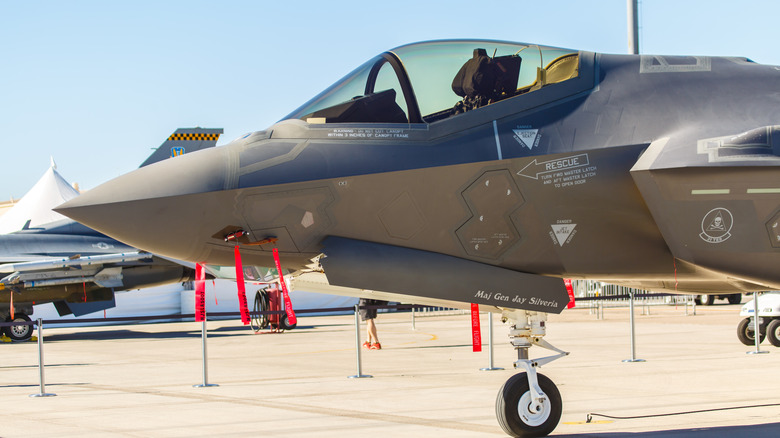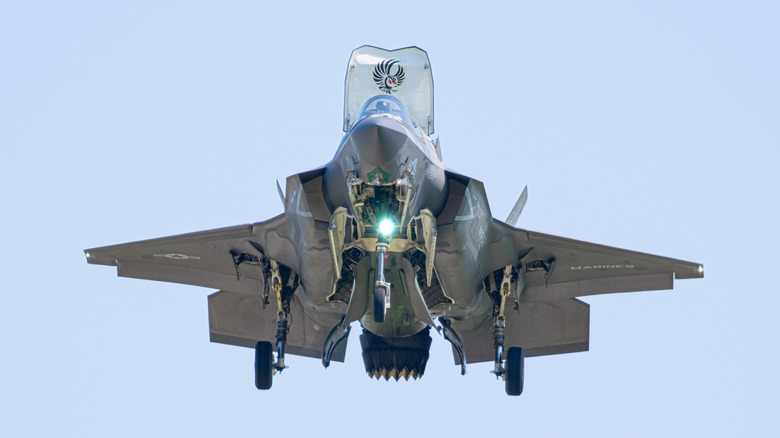The Life-Saving Feature That Makes The F-35 Ejection Seat Unique
The F-35 Lightning II is among the most lethal aircraft ever created by man, a force of nature when it comes to annihilating the enemy. The fighter jet is unique in many ways, whether it's its custom-made helmets for each pilot or one of its variants capable of short take-offs and vertical landings. It is also regarded as the most advanced fighter jet to date, and with good reason. Some might mention its firepower and stealth capabilities, while others will talk about its speed and maneuvering capabilities.
Others, however, may talk about it having a one-of-a-kind life-saving ejection seat, which might be a little costly at $120,000 each, but will work hard to ensure a pilot is safe in case the plane goes up in flames. The F-35's seat achieves this through several features, importantly, its wide range of anthropometric accommodations, which allow it to eject all pilots safely regardless of their size and weight, and its design specifications that meet the Neck Injury Criteria (NIC), a metric used to assess the risk of neck injury during ejection.
The seat also includes an oxygen supply, thermal cooling, anti-G protection, in-helmet communications, and the helmet-mounted display (HMD). It can also release its integrated harness when landing in water, deploying the seat's parachute and a life raft. There's also a special variant that only comes in the F-35B, which has auto-eject capabilities. Today, we're discussing the F-35's ejection seat and how it stands out compared to other fighter jet seats.
Martin-Baker makes the ejection seats for the F-35
While Lockheed Martin won the contract for developing the F-35 Lightning II, numerous companies from all over the world stepped up to lend a hand in making the craft a reality. Among these companies was Martin-Baker, an aviation company that has focused on developing "reliable, cost-effective and easy-to-maintain crew escape system upgrade solutions" since the mid '40s. Among some of their products is the US16E Ejection Seat, which every variant of the F-35 is equipped with.
The seat comes with several nifty features, including a twin catapult ejection gun, an MG5 integrated harness, and an IGQ 6000 parachute, as well as performance parameters that account for safe terrain clearance limits and physiological loading limits. It also includes a survival kit with the aforementioned life raft.
The seat has arm and leg restraint systems and an operating ceiling of 50,000 feet. Additionally, it has a minimum speed and height of zero, allowing deployment regardless of the fighter jet's speed and altitude. But what truly distinguishes the seat from those used in other fighter jets is the auto-eject feature that comes with the F-35B variant.
The F-35B comes with a specialized version of the US16E ejection seat
While nowhere near as quick as the blindingly fast F-22 Raptor (1,534 miles per hour), the F-35 has been known to reach speeds of over 1,228 miles per hour, which, for those out of the loop, is beyond the speed of sound. Now, imagine a pilot ejecting from his seat while the jet is cruising at such speeds. All of a sudden, normal environmental conditions turn into a hellish landscape that the pilot is meant to endure until their seat can decelerate to optimal speeds. The danger can be doubled for pilots who fly the F-35B, which is known to have STOVL and hovering capabilities.
You might argue that adding more systems to a machine widens the likelihood of mishaps and problems. For the F-35B, issues could arise during its hovering and short takeoff and vertical landing sequences just as they might during flight. That's where the auto-eject system, combined with the seat's minimum height and speed deployment requirements, plays a crucial role. In 2022, EurAsian Times (via YouTube) shared a video of an F-35B crashed at Joint Reserve Base, Fort Worth, where the US16E ejection seat auto-ejected just in time to save the pilot from the aircraft.


